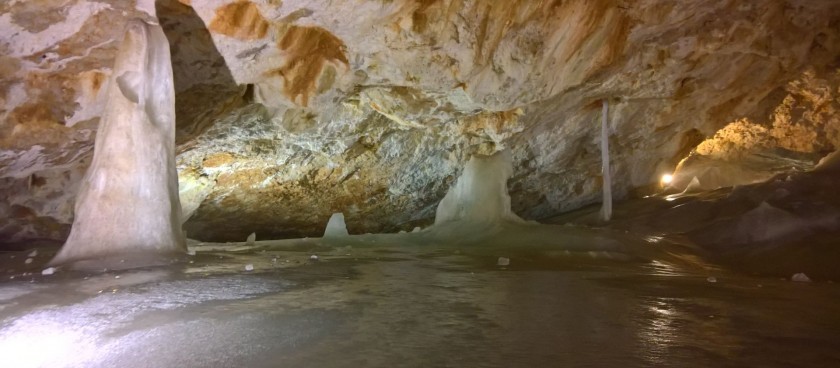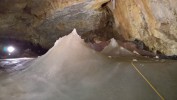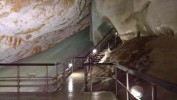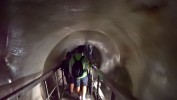- #SK01
- Hodžova 11, 031 01 Liptovský Mikuláš, Slovakia
- +4210445536101
- caves@ssj.sk
- http://www.ssj.sk/en/jaskyna/6-dobsin...
- Working hours*:
9:00, 10:00, 11:00, 12:00, 13:00, 14:00, 15:00, 16:00 - Prices*:
Adults - 8Eur;
Children 6-15y., handicapped people - 4Eur;
Students, > 60 years - 7Eur. - * - opening and closing times as well as entrance prices, are subject to alterations without notice. Visitors are advised to check before visiting.
- 48.8742900, 20.3026090 Copy to clipboard Copy
-
#Family time , #Caves
Average temperature in glaciated parts:-3,9 až -0,2°C
Average temperature in non-glaciated parts:0,8 až 3,5°C
The entrance to the cave is on the northern slope of the Duča Hill at elevation of 969,5 m, cave length is 1,483 m. Duration of visit: 515 m. Cave spaces go down from the beginning, which togheter with northern orientation enables the descent of cold air and overall cooling of the cave.
The cave has several magnificent parts – Great and Small Halls, Ruffiny’s Corridor and Collapsed Dome. The parts without ice have names Dripstone and White Hall, Dry Dome, Dripstone Cellar and Hell. Air temperature in the Great Hall is from -3,8 to + 0,5 C. The visitors descend only several tens meters underground and find themselves in an ice kingdom of cold and perfect products of the mother Nature.
One of the interesting facts on the cave is that up to the 1946 a skating for public was permitted all year round. The well known Czechoslovak figure skater Karol Divín and a company of military speed skaters trained here in the fifties.
How to prepare for the tour
Vertical distance and temperature differences between outside and inside environment can cause a specific load on organism. It is necessary to take a rest before entering the cave for easier acclimatization. Warmer clothes and firm boots are recommended.
Dobšinská Ice Cave is a part of the Stratená Cave System. It is formed in the Middle Triassic pale Steinalm and Wetterstein limestones of the Stratená Nappe, along the tectonic faults and interbed surfaces. The cave reaches the length of 1,491 m and vertical span of 112 m.
The main part of the cave is represented by a giant cavity descending from the entrance to the depth of 70 m, which was formed by breakdown of rock columns between the passages formed by ponor palaeoflow of Hnilec in several development levels. At present, the most of its volume is filled with glacier, sometimes up to the ceiling, by which it is divided into individual parts (Great and Small Hall, Ruffiny’s Corridor and Ground Floor). Collapsed Dome (Zrútený dóm) is partly glaciated, and its edge reaches as far as under the Duča breakdown. Original oval shapes of river modelling are almost entirely destructed by collapses and frost weathering.
Dobšinská Ice CaveThe upper non-glaciated parts of the cave are formed prevailingly by horizontal passages and halls with typical oval shapes and ceiling channels. There are also some forms of flowstone fills in the non-glaciated parts of the cave (stalagmites, stalactites, flowstone crusts, layers of moonmilk).
Dobšinská Ice CaveConditions for glaciation arose probably in the middle Quaternary period after the breakdown of ceilings between the Dobšinská Ice Cave and Stratenská Cave, by which the cave obtained sack-like character with stagnation of cold air that penetrated into the cave through the upper opening formed by collapse of the ceiling part (present entrance to cave). Freezing the percolating rainfall waters caused glaciation of the underground space. The beginnings of ice formation go back to the Riss ice age (approx. 300- to 140-thousand years ago), or until the end of the Mindel ice age.
Ice fill occurs in the form of floor ice, icefalls, ice stalagmites and columns. Glaciated surface has 9,772 m2, ice volume reaches 110,100 m3. The highest thickness of ice is in the Great Hall with 26,5 m. The floor ice is characterized by its stratification. The decrease of ice takes place by melting on the contact with the bedrock. Continuous replacement of the underground glacier supposedly takes around 1,700 up to 2,000 years. The ice is slowly moving from the entrance, Small and Great Hall towards the Ground Floor and Ruffiny’s Corridor (2 to 4 cm a year). The Dobšinská Ice Cave belongs among the most significant ice caves in the world, which is accentuated by its location outside the Alps high-mountain region (underground ice is at elevation of 920 to 950 m n. m.).
Average annual temperature of air in the glaciated Great Hall reaches –0,4 to –1,0 °C (in February –2,7 to –3,9 °C, in August around +0,2 °C). The temperature in the bottom parts of the cave remains under the freezing point all the year round. Relative air humidity in non-glaciated parts is mostly 75 to 90 %, sometimes over 90 %. Air temperature in the non-glaciated parts of the cave fluctuates between +0.8 and +3.5 °C, relative humidity between 85 and 98 %. The cave is of static-dynamic character and different winter and summer regime of air flow circulation. In winter the cold air flows underground and in summer vice versa.
The cave stands for the most important wintering place of the Whiskered Bat (Myotis mystacinus) and Brandt’s Bat (Myotis brandtii) in the central Europe. From among 12 species that were found in the cave important is the occurrence of the Pond Bat (Myotis dasycneme) and Natterer’s Bat (Myotis nattereri), which belong among the rarest bat species in Slovakia.
History
Opening to the cave called “ice hole” was known since long time ago. However, it was only E. Ruffíni accompanied by G. Lang, A. Mega and F. Fehér who descended underground in 1870. Thanks to the Dobšiná town, the cave was opened for the public as early as 1871. Experiments with electric lighting began in 1881. Regular electric lighting was introduced in 1887. The cave belongs among the first electrically illuminated caves in the world. Immediately after the discovery the cave took attention of both experts and public and many of that time personalities visited the cave – P. O. Hviezdoslav, S. H. Vajanský and others. A concert was held in the Great Hall in 1890 to the tribute of Karl Ludwig von Habsburg. It was known also by summer skating, which took place for the first time in 1893. J. Mišelnický discovered the Dripstone Hall, J. Ogurčák the Northern Corridor and L. Šimkovič the White Hall in 1947. During 1953 – 1954 a general repair of the show path and electric lighting was done as well as protection measures after the discovery of non-glaciated parts. Public has access to 475 m with elevation range of -43 m.



